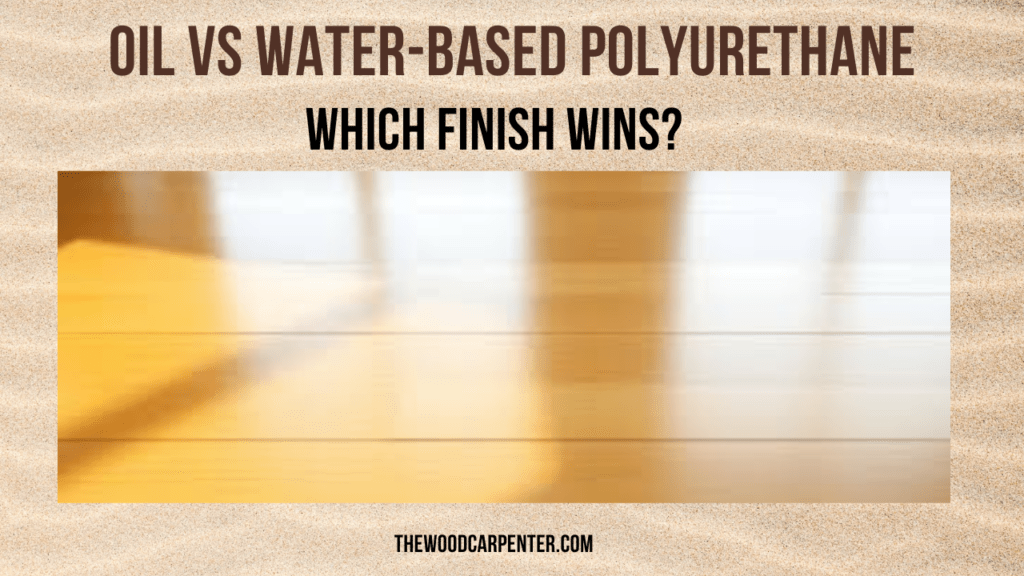
If you are protecting wood (and want to bring out the beauty of that wood a bit), then polyurethane is one of your go-to finishes. Whether you’re refinishing hardwood floors or sealing a piece of furniture, someday you’ll find yourself in front of a can of polyurethane at the hardware store, asking a simple question: Do I want water-based or oil-based?
Each has its perks — and cons, a few of which we will outline — so understanding the differences can point you to which one is right for your next project. In this guide, we’ll break it down, and do a side-by-side comparison of the two, as well as share pro tips to getting a perfectly smooth finish.
What Is Polyurethane, Anyway?
Let’s start simple.
Polyurethane, or urethane, is a clear protective covering that is put over wood or paint. Call it a thin armor for your floors, furniture or cabinetry. It emphasizes thewood grain, and has a durable lustre.
There are two main types:
- Water-based polyurethane
- Oil-based polyurethane
While both serve the same purpose, they differ in look, durability, odor, drying time, and even cost. Understanding these differences is key to getting the finish you want.
Water-Based Polyurethane: Modern, Clean, and Fast
✅ What It Is
Water based polyurethane has water as its main solvent, not tough chemicals. That makes it low in odor, fast-drying and easier for clean-up (soap and water is enough).
🌟 Appearance
In the can, it appears somewhat milky, but don’t worry — it dries completely clear. That means it’s not going to alter the color of your wood, so it’s great if you’re trying to maintain a natural or light tone. If you’re using maple, ash or birch, water-based poly will keep that fresh, light look for years.
🕒 Drying & Curing Time
One of its biggest advantages is speed. You can apply multiple coats in a single day since each coat dries in about 2–4 hours. For busy DIYers or pros on a schedule, that’s a big win.
💪 Durability
Now, here’s the catch: because water-based poly has fewer solids, it’s thinner and may require more coats (typically 3–4 or even up to 8 for floors) to reach the same level of protection as oil-based.
Modern formulations have improved a lot, though. High-quality brands like Bona and Varathane have made water-based finishes tough enough for residential floors and high-traffic areas.
🌿 Eco-Friendliness
Water-based polyurethane is also better for the environment and your indoor air quality. It releases fewer VOCs (volatile organic compounds), which means less odor and fewer harmful fumes.
🧹 Cleanup
Cleanup is a breeze — you just need warm water and soap. No need for paint thinner or mineral spirits.
⚠️ Drawbacks
- More expensive per quart than oil-based
- Requires more coats for the same level of durability
- Can be tricky to apply evenly since it’s clear and dries fast
Oil-Based Polyurethane: Classic, Warm, and Tough
✅ What It Is
Oil-based polyurethane has been around for decades. It’s solvent-based, typically using mineral spirits, which gives it that strong smell and longer drying time — but also the deep, rich look many people love.
🌟 Appearance
If you’re going for that classic amber glow, oil-based poly is unbeatable. It brings warmth and depth to wood, enhancing the natural grain beautifully. Over time, it continues to darken slightly, giving the wood a rich patina that many homeowners adore.
This type of finish looks amazing on oak, cherry, walnut, or mahogany — woods that benefit from that golden tone.
🕒 Drying & Curing Time
Patience is key here. Oil-based poly can take 8–12 hours per coat to dry and may need several days to cure fully. You’ll usually need only 2–3 coats, but each coat requires good ventilation and longer wait times.
💪 Durability
Oil-based polyurethane forms a thicker, harder layer with fewer coats. It’s known for excellent abrasion resistance, making it ideal for floors, stairs, and high-traffic areas.
🧹 Cleanup
Cleanup isn’t as fun. You’ll need mineral spirits or paint thinner, and you’ll definitely notice the smell — it’s strong and lingers for days.
⚠️ Drawbacks
- High odor and VOCs
- Yellows over time (which can be a plus or minus)
- Longer drying and curing time
- Requires solvent cleanup
Water-Based vs. Oil-Based Polyurethane: Side-by-Side Comparison
| Feature | Water-Based Polyurethane | Oil-Based Polyurethane |
| Color | Dries clear; keeps wood light | Adds a warm amber glow |
| Odor | Low | Strong, solvent smell |
| Drying Time | 2–4 hours per coat | 8–12 hours per coat |
| Durability | Very good (more coats needed) | Extremely durable (thicker film) |
| Number of Coats | 3–5 coats (or more) | 2–3 coats |
| Cleanup | Soap and water | Mineral spirits |
| Cost | Slightly higher | Lower |
| VOCs (Fumes) | Low | High |
| Finish Types | Satin, semi-gloss, gloss | Satin, semi-gloss, gloss |
| Color Change Over Time | None | Amber/yellowing increases over time |
Which Polyurethane Is Better for Floors?
If it’s a hardwood floor refinishing job, your decision may be based on lifestyle, type of wood and personal preference.
Choose water-based polyurethane if:
- You’re after a natural, sheer finish.
- You need faster drying times.
- You’re sensitive to smells or fumes.
- You may be hanging light-color wood or contemporary interiors.
Choose oil-based polyurethane if:
- You prefer a warm, rich tone.
- You want maximum durability.
- You don’t mind waiting more time between coats.
- You’re finishing darker woods, or dealing with a rustic-style interior.
Water-based polyurethane has fewer solids (30–35%), so you’ll be applying more coats to build the thickness that oil-based provides (45–50% solids). But with newer water-based technologies, durability has caught up significantly.
Tips for Applying Polyurethane (and Getting a Pro Finish)
Whether you choose water- or oil-based, technique matters just as much as the product.
- Sand properly. Start with medium-grit sandpaper, then finish with fine grit for a smooth surface. Always sand between coats.
- Apply thin, even coats. Too thick a coat can cause drips or bubbles.
- Use the right applicator. Synthetic brushes or foam pads for water-based; natural bristle is best for oil-based.
- Work in good lighting. Especially with water-based finishes, because it’s difficult to see where you’ve already put some on.
- Avoid dust. Work in a clean, airy area to avoid inflexible particles getting stuck.
- Let it cure. Even when it feels dry to the touch, full curing may take days. Don’t place heavy furniture or rugs on floors right away.
Cost and Value: Which One Wins?
While water-based polyurethane costs more upfront, the savings in time, ventilation needs, and odor control can make it worth it for many homeowners.
Oil-based polyurethane, on the other hand, is cheaper per gallon, lasts slightly longer between refinishings, and creates a more “premium” look for traditional interiors.
So the right choice depends on what you value more:
- Convenience and clarity? Go water-based.
- Depth and durability? Go oil-based.
Environmental and Health Considerations
For homes with pets, kids or anyone particularly sensitive to fumes, water-based polyurethane is the safer option. It has fewer volatile organic compounds, which is better for the air quality in a home while it’s being applied and afterward.
Oil-based polyurethane still has its uses — but be sure to ventilate well and wear a respirator if you’re applying multiple coats indoors.
Final Thoughts: The Right Choice for Your Project
At the end of the day, both types of polyurethane can deliver stunning, long-lasting results. It all depends on your priorities:
- Go water-based If you want low-odor, eco-friendly and fast-drying, go water-based
- Go oil-based Opt for oil-based if you adore that gold, luscious patina and require bulletproof durability on high-traffic floors.
Either way, taking your time with prep, sanding, and even application will make all the difference between an average job and a professional-looking finish.
FAQs About Polyurethane Finishes
1. Does oil-based polyurethane last longer than water-based?
Yes — oil-based finishes typically wear a little longer, because of their thicker film and higher solids, but today’s waterborne polys are catching up fast.
2. Can you put water-based polyurethane over oil-based?
Not directly. You will need to sand and clean the surface very well, or use an industrial bonding sealer to make sure it adheres.
3. How long should you wait before walking on polyurethane floors?
With water-based poly, light foot traffic is usually okay after 24 hours. For oil-based, wait at least 48 hours, preferably longer.
4. Why does oil-based polyurethane turn yellow?
That is part of its chemistry — as the finish ages, the oil in its formula oxidizes and gives it that warm amber hue.
5. Is water-based polyurethane durable enough for floors?
Yes! High-quality water-based finishes (like Bona Traffic HD or Varathane Crystal Clear) are extremely tough and they can easily handle the normal household traffic.

